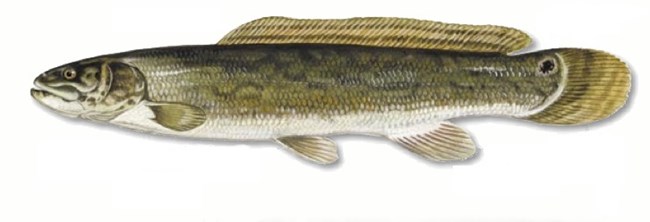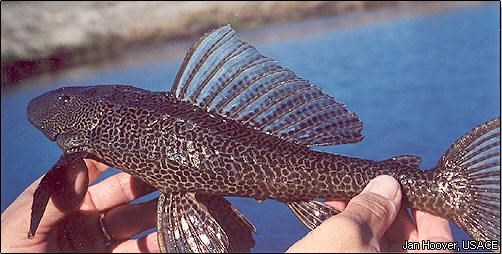|
Big Cypress National Preserve is home to 66 species of fresh and saltwater fish. Look into any body of water in the Preserve, and you will likely see a fish swimming by! Here are a few of the common fish you might see in the Preserve. 
Appearance: This long, narrow fish has an olive-brown back with a pale belly and is covered in dark, irregular spots. They have small fins and an elongated snout containing a row of teeth on each jaw. Other than the underside of their throat, their body is covered in bony, interlocking scales that act as an armor against predators. Size: Florida Gar can be around 1.1-2.8 feet in length, with females growing larger than males. Habitat: Florida Gar can be found in lakes, streams, and canals with muddy or sandy bottoms and underwater vegetation, which they use to ambush their prey. Diet: Juveniles feed on small fish, zooplankton, and insect larvae. Adults primarily eat fish, but they will also eat insects and crustaceans such as shrimp and crayfish. Florida Gar stalk their prey by using tiny movements of their fins to swim slowly up to it, then turning their head sideways and grabbing the prey with their teeth. Reproduction: Florida Gar spawn primarily in late winter and early spring. The female lays adhesive eggs in shallow, weedy water, where they are fertilized by nearby males. Once hatched, the juvenile gar will use an adhesive disc to attach themselves to gravel and vegetation, remaining there until they reach a length of around 3/4 inches. 
Appearance: Bowfin have an elongated body with a long dorsal (top) fin extending down their back. They are a mottled olive color with a pale underbelly. Adult males have a black spot rimmed with orange at the base of their tail. Size: Females can reach 2.5 feet in length, with males reaching 1.5-2 feet. Habitat: Bowfin can be found in swamps, sloughs, lakes, and the backwaters of lowland streams. They can survive in warm, poorly oxygenated waters, and are often found near vegetation. Diet: Young Bowfin feed on plankton, while adults eat primarily fish. Reproduction: Mating takes place from April-June, and begins with the male clearing a circular nest 1.2-3 feet in diameter in an area of heavy vegetation. After a mating ritual involving nose biting, nudging, and chasing, the female will lay her eggs in the nest. The male guards the eggs, which hatch after 8-10 days. The juveniles use an adhesive organ to attach themselves to rootlets until they are 9 days old, after which they will follow the male in a school until they are ~4 inches in length. 
Photo Courtesy of Bill Loftus Appearance: Eastern Mosquitofish are silver to forest green with a pale belly. Dark outlining around their scales often gives them a cross-hatched appearance. They have a rounded tail fin and a small, distinctly upturned mouth. Size: This small fish will reach about 2-3 inches in length. Habitat: The most common freshwater fish in Florida, Eastern Mosquitofish can often be found in vegetated areas of ponds, lakes, swamps, backwaters, and canals. They are occasionally found in brackish water. Diet: Eastern Mosquitofish eat small insects, crustaceans, and plant material. Reproduction: Eastern Mosquitofish are live bearers, meaning they produce live young instead of laying eggs. Pregnancy lasts approximately one month, after which the female gives birth to 40-60 offspring. 
Invasive Species Appearance: Orinoco Sailfin Catfish are gold with dark, irregular spots. They have a large, sail-like fin on top of their body and, excluding their belly, are covered by rows of bony plates. Their suction cup-like mouth is on the underside of their head. Size: This fish can reach lengths of more than 1.6 feet. Habitat: Native to South America, the Orinoco Sailfin Catfish was likely introduced to Florida through escapes or releases from the aquarium trade. In Florida they are found in lakes, ponds, canals, and slow-moving streams, particularly in shallow areas or near the shore. Species in this genus can survive in poor quality water. Diet: Orinoco Sailfin Catfish feed on detritus and algae they scrape from surfaces using their teeth. They will also consume a small number of aquatic invertebrates and fish eggs, possibly unintentionally while they are feeding on plant matter. Reproduction: Most breeding occurs between April and September. The male constructs a burrow for the female to lay her eggs. Each female can lay around 2,000 eggs. The burrows are then guarded until the eggs hatch. |
Last updated: November 1, 2021
